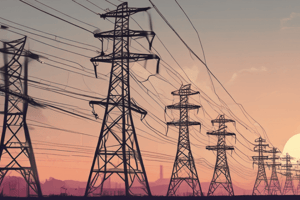Podcast
Questions and Answers
What is the main purpose of an electrical distribution system?
What is the main purpose of an electrical distribution system?
- To transmit electricity over long distances
- To efficiently deliver electricity to end-users (correct)
- To generate electricity
- To store electricity
Which component is NOT typically part of an electrical distribution system?
Which component is NOT typically part of an electrical distribution system?
- Power lines
- Transformers
- Meters
- Generators (correct)
What part of the power system connects the transmission system to the consumers' meters?
What part of the power system connects the transmission system to the consumers' meters?
- Circuit breakers
- Fuses
- Substations
- Feeders (correct)
What is the purpose of transformers in an electrical distribution system?
What is the purpose of transformers in an electrical distribution system?
What is the function of circuit breakers in an electrical distribution system?
What is the function of circuit breakers in an electrical distribution system?
In a low tension distribution system, what is the role of service mains?
In a low tension distribution system, what is the role of service mains?
What is the primary reason for the high cost of an underground system compared to an overhead system?
What is the primary reason for the high cost of an underground system compared to an overhead system?
What is a key advantage of overhead systems over underground systems in terms of flexibility?
What is a key advantage of overhead systems over underground systems in terms of flexibility?
What is a notable feature of the appearance of underground systems that is influencing electric supply companies?
What is a notable feature of the appearance of underground systems that is influencing electric supply companies?
Why are faults less common in underground systems compared to overhead systems?
Why are faults less common in underground systems compared to overhead systems?
How do underground systems differ from overhead systems in terms of fault location and repairs?
How do underground systems differ from overhead systems in terms of fault location and repairs?
Which system offers better ease of fault location and repairs due to visible conductors?
Which system offers better ease of fault location and repairs due to visible conductors?
Why is there no interference with the underground system in terms of power line currents superimposed on speech currents?
Why is there no interference with the underground system in terms of power line currents superimposed on speech currents?
What is the main advantage of a radial distribution system over other systems?
What is the main advantage of a radial distribution system over other systems?
When would a radial distribution system be preferred for power distribution?
When would a radial distribution system be preferred for power distribution?
What is a key drawback of a radial distribution system?
What is a key drawback of a radial distribution system?
In which type of distribution system do separate feeders radiate from a single substation and feed the distributors at one end only?
In which type of distribution system do separate feeders radiate from a single substation and feed the distributors at one end only?
Why do power line currents superimposed on speech currents raise the potential of the communication channel to an undesirable level?
Why do power line currents superimposed on speech currents raise the potential of the communication channel to an undesirable level?
What is the main purpose of the primary distribution system in an A.C. distribution system?
What is the main purpose of the primary distribution system in an A.C. distribution system?
What are the most commonly used voltages for primary distribution?
What are the most commonly used voltages for primary distribution?
How is primary distribution carried out due to economic considerations?
How is primary distribution carried out due to economic considerations?
What determines the voltage used for primary distribution?
What determines the voltage used for primary distribution?
What is the primary purpose of a step-down substation in an A.C. distribution system?
What is the primary purpose of a step-down substation in an A.C. distribution system?
What distinguishes the primary distribution system from secondary distribution system in an A.C. distribution setup?
What distinguishes the primary distribution system from secondary distribution system in an A.C. distribution setup?
What is a key disadvantage of the radial system connection scheme of a distribution system?
What is a key disadvantage of the radial system connection scheme of a distribution system?
Why are consumers dependent on a single feeder and distributor in the radial system?
Why are consumers dependent on a single feeder and distributor in the radial system?
In a ring main system, why do the distributors receive supply from different points of the feeder?
In a ring main system, why do the distributors receive supply from different points of the feeder?
What happens in the ring main system in the event of a fault on any section of the feeder?
What happens in the ring main system in the event of a fault on any section of the feeder?
Which feature contributes to the high reliability of the ring main system?
Which feature contributes to the high reliability of the ring main system?
Why is the radial system generally used for short distances only?
Why is the radial system generally used for short distances only?
Flashcards are hidden until you start studying




